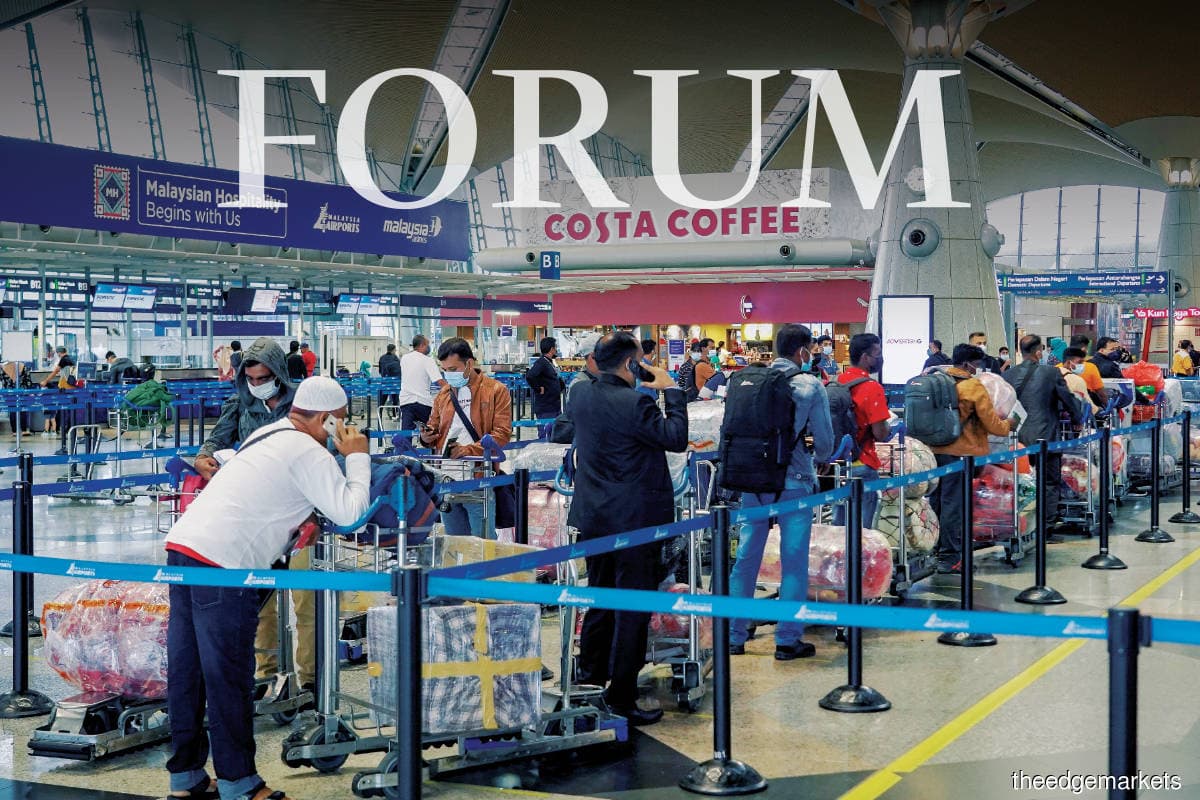
This article first appeared in Forum, The Edge Malaysia Weekly on March 21, 2022 - March 27, 2022
Come April 1, Malaysia will reopen her borders, which had been closed since March 2020 owing to the Covid-19 pandemic. The decision is deeply significant and momentous for several reasons.
First, it marks the final phase in the unshackling of our movement restrictions, part of the government’s effort to curb the spread of the coronavirus. For the past two years, different iterations of border and movement controls were implemented because our lives literally depended on it.
After April 1, it will be easier for Malaysians to travel abroad, which is something most of us have been unable to do since the pandemic hit our shores. Likewise, foreign tourists will be able to visit Malaysia more freely to soak in our famed beaches, cultured history, fabulous food and renowned warm hospitality.
This brings us to the second point about why April 1 is a momentous event for the country. The inflow of tourists and other travellers into the country is critical to not only kick-start our pandemic-battered tourism industry, but also to provide a strong impetus for our post-Covid-19 economic recovery.
Pre-Covid-19, tourism was a major contributor to our gross domestic product. In 2019, tourism contributed 13.3% to our GDP. The 26.1 million international tourists who visited Malaysia that year spent some RM86.14 billion.
Additionally, pre-Covid-19, tourism and tourism-related sub-sectors such as retail, transport, as well as food and beverage, hired an estimated three million workers. All these made up the gross value added for tourism industries (GVATI) of RM240.5 billion, or 15.9% of GDP, in 2019. This added to the government’s revenue in the form of taxes, which are then ploughed back into the economy through development projects, including building schools, roads and hospitals.
Since the gradual opening of state borders in October 2021, I believe we have turned the corner insofar as tourism is concerned. Nonetheless, it is the reopening of our international borders on April 1 that is much anticipated, because that is what will truly revive the industry, as international travellers can now visit Malaysia, whether for business or leisure.
I left for an overseas working trip on the afternoon of March 17 and felt heartened to see that KLIA was once again teeming with travellers, with most retail outlets having reopened. Be that as it may, the Ministry of Finance is realistically aware that the projected tourist arrivals this year will not likely catch up with the 2019 figure of 26.1 million any time soon.
In fact, the United Nations World Tourism Organisation only expects international tourism to return to pre-pandemic levels by 2024, at the earliest. Further, the Omicron variant, the Russia-Ukraine conflict and the ensuing sharp rise in commodity prices, particularly oil, have put a dampener on prospects for a quick economic recovery.
Nonetheless, the reopening of Malaysia’s international borders is still a positive development for our economy. Our GVATI for 2022 is projected to be RM206.8 billion, or 12.6% of GDP. This will certainly contribute to our service sector’s expected 7% growth, which in turn, will contribute to the 2022 GDP growth projections of between 5.5% and 6.5%.
Malaysia’s growth this year will continue to be driven by encouraging external trade. In 2021, we recorded external trade exceeding RM2.2 trillion. In January this year, our external trade grew by 25% and in February, by 17.5%.
In helping the industry to recover sooner, the government has also extended the Wage Subsidy Programme (WSP) to the tourism sector this year. Through Budget 2022, RM600 million has been allocated for this programme, which is expected to benefit 330,000 employees and 26,000 employers. The Ministry of Finance also extended until this year end the special individual income tax relief for domestic tourism expenses of up to RM1,000. Additionally, over 20,000 tour operators registered with the Ministry of Tourism will also get assistance valued at RM85 million for three months. Hopefully, these will help the government create the targeted 600,000 new jobs this year and reduce unemployment to less than 4% by end-2022.
But what is equally, if not more important, is how the financial institutions will step up to support this industry and help it recover speedily from its two-year setback. Measures such as a special RM600 million facility under the Penjana Tourism Financing and the BPMB Rehabilitation Schemes will certainly help. There are various other financing measures under the RM40 billion SemarakNiaga initiative, curated specifically to help businesses recover faster and help them grow. For micro, small and medium enterprises (SMEs), there are even a few financing schemes at 0%, coupled with a moratorium of up to 12 months.
The financial institutions’ support is key to reinvigorating a sector to help it regain its crown as one of the largest contributors to our GDP. For businesses that have been hit hard these last two years, equity and quasi-equity financing are options they could consider for the funding required to help them get back on their feet.
My fervent hope is that financial institutions will do their best to facilitate access to funding for these businesses. Because, just like a rising tide that lifts all boats, a growing tourism industry will have a knock-on, positive impact on many other sub industries, reflecting the cooperative spirit of Keluarga Malaysia not only in surviving, but also thriving together.
Tengku Datuk Seri Zafrul Abdul Aziz is Malaysia's Minister of Finance
Save by subscribing to us for your print and/or digital copy.
P/S: The Edge is also available on Apple's AppStore and Androids' Google Play.